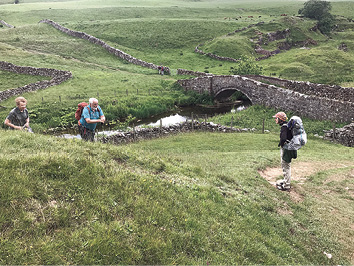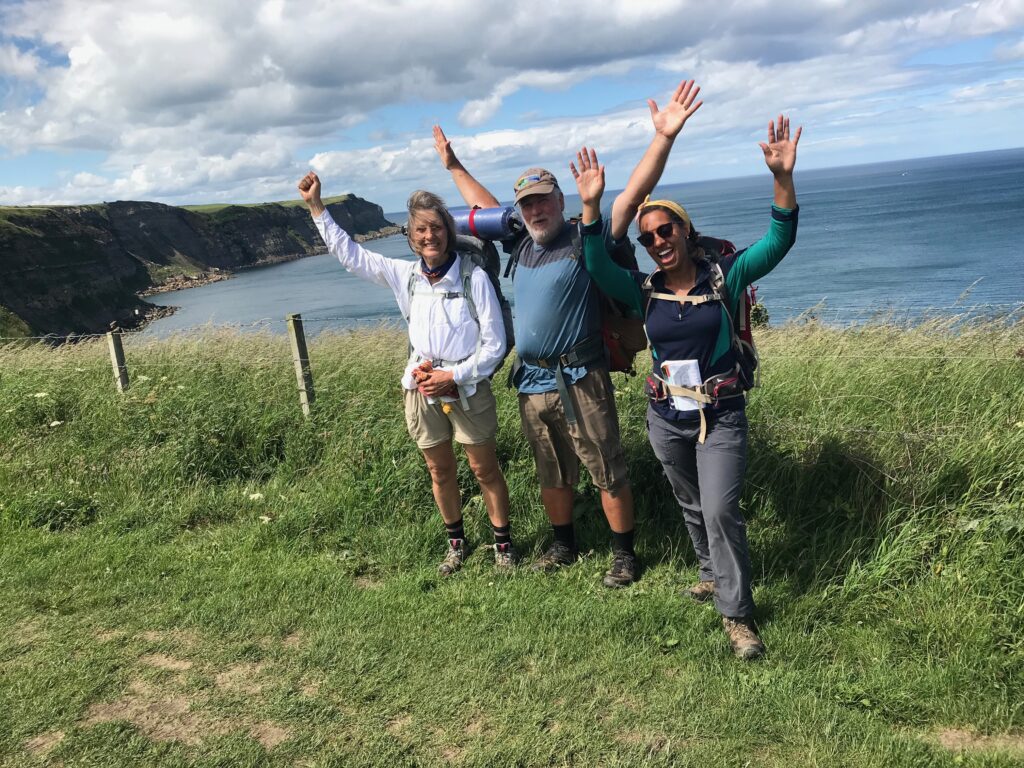My preferred mode of wilderness travel is definitely by canoe. However, not all routes or destinations are along waterways or accessible by canoe, so at times I find myself compelled to strap on a backpack and travel overland. Don’t get me wrong; I love to hike. Rather, I am not partial to the minimalist camping backpacking requires, specifically with respect to food. The physical challenges of a long slog over rugged terrain are not sufficiently rewarded by a meal prepared by boiling water and throwing it into a bag of dried food. So, when a backpacking friend proposed a hike along Wainwright’s Coast to Coast Route across England, my interest was piqued. What could be better than finding oneself seated at a pub after many miles on the trail?
In the end I experienced 16 fairly grueling days hiking from St. Bees on the coast of the Irish Sea to Robin Hood’s Bay along the North Sea, 192 miles in all. And yes, I was rewarded by a pint and a hot meal, usually in a pub, at the end of each day.
Initially, the trail follows the coast for about 4 miles. On one’s left are fabulous views of the Irish Sea from atop St. Bees Head; on the right: sheep. The cliffs along the shore are rife with the sounds and flight of thousands of nesting seabirds. All the while, intrepid hikers get their first taste of traversing farmland and quickly learn the futility of trying to avoid sheep droppings and the intricate dance of passing through fence after fence, most with “kissing gates.” These gates are rather like half a revolving door with a small rectangular enclosure. One must enter the enclosure, open the gate, which is usually spring-loaded, pass through the gate, then close and latch the gate. Some of the enclosures were clearly not designed for backpackers, certainly not for a stocky Scandinavian with a fairly large pack. At times I had to climb the fence in order to clear the gate. At other times there were jutting stones to be used as steps to climb over the fences. After we turned our backs to the ocean and strode inland, we still had another 10 miles of hilly terrain before we reached Ennerdale Bridge and our first stop.

Thirsty we were and grateful for respite as we reached the Fox and Hounds, where we had permission to pitch our tent in their beer garden. The much anticipated first draught came with a bit of a surprise, as I had momentarily forgotten that the British serve their ale at room temperature. Non-the-less, I happened upon what would be my favorite: Black Sheep Bitter. It’s dark amber color, an initial sweetness and maltiness, followed by the classic bitter finish, won me over. The 14-mile hike may have influenced my perceptions a bit. We also got our first taste of the pub menus of this region. Wherever we went, we were sure to find plenty of meat and potatoes served with fresh vegetables, usually peas. There was always at least one meat pie, perhaps a shepherd’s pie, some sort of chicken, often roasted, fish, sometimes wild game, a curry dish, and often pasta. The portions were usually fitting for one who had walked 14 miles or so.
We also learned that we had to reserve a table when we arrived, reserve breakfast for the next morning, and order a bag lunch.
Ennerdale Bridge is at the gateway to the Lake District. The Lake District should really be called the Mountain District, since it mostly consists of mountains, with pastoral views of lakes cradled between the peaks. The Lake District is also the first of three national parks we would cross on our journey. Because it is a national park, the trail markings did not designate whether or not we were on the Coast to Coast Route, which is not an official trail but a route along many existing trails. Here, trails intersected our intended path frequently. We consulted our map book often, which was not to the scale of a Boundary Waters map, and managed with only a couple of minor mishaps. We had a guidebook as well, which offered useful advice. One of the difficulties in navigating across England is the terminology for geographical features. The list of unusual, yet very specific, terms include, wood, dale, fen, tarn, crag, col, gil, beck, fell, moor, pike, water, knot, burn, tongue, cape, how, ghyll, force, scar, mere, and copse. We mentioned this to a couple we befriended on the trail and they laughed quite heartily and admitted that the terms were so local and specific they were confusing to everyone.
On the third day, we reached Grasmere, which was a highlight for me because the poet William Wordsworth lived there and was inspired by his treks throughout the region. We also had reserved a room at a hostel and were able to shower and sleep in a bed. Nice.
An explanation about English breakfasts is in order. Every establishment offered what was called a full breakfast. Its make-up was amazingly consistent along the route, and we generally ordered this for simplicity’s sake—though we later learned we could exclude items we didn’t want. A full breakfast includes sausage, bacon, an egg or two made to order, mushrooms, baked beans, toast, coffee or tea, and black pudding. Black pudding is a cross between blood sausage and oatmeal. Or rather, it is a blood sausage with oats. It arrives on your plate sliced into circular patties. It’s an acquired taste, but one that I acquired.
After four lovely but grueling days, we descended sharply from the Lake District. Much of the middle section of the hike cut through the Yorkshire Dales National Park. There we followed the River Swale and were treated to amazingly pastoral views of the British countryside. There were still plenty of elevation changes and quite a number of boot-sucking bogs to contend with. Along our way was an abandoned abbey, an ancient castle, the remnants of a Roman road, and a strange collection of huge rock structures called the Nine Standards, lined like sentinels atop a hill.
One of the delights, as time and opportunity permitted, was the opportunity to stop for tea and scones. On the path from Reeth to Richmond there is a farm with a tea shop named Elaine’s, known for its award-winning scones. It was a delightful stop amid an otherwise unspectacular hike, and the scones were wonderful. Elaine was delightfully accommodating and offered us advice for navigating the trail as well as her home remedy for blisters—raw wool. Its natural oils contain lanoline, and when put under one’s socks, it provides both cushion and relief.
Lastly, we entered the North Yorkshire Moors National Park. This region featured lots of elevation changes and wonderful vistas. By the end of our hike, the heather was beginning to bloom, so we were treated to the wonderful maroon blossoms and a variety of other wildflowers. The moors are boggy, as is much of England, and our feet were seldom dry.
Kathy McClure, Chuck Viren, Phiul Deering, and Randi McClure at the end of the 192-mile Wainwright Coast to Coast Route. |CHUCK VIREN
Perhaps the highlight of this section was our stop at the Lion Inn at Blakey Ridge. This is a 500-year-old inn initially established by the Order of the Crouching Friars. I’m not sure if there is a connection, but the doors were little more than 5 feet high. The food there was excellent, and the portions were ridiculously large. I ordered the lamb chops and got six. We were tenting it outside with the sheep (it’s small wonder lamb was so abundant). The inn was situated high up with fantastic views of the moors. Throughout the evening, many fancy cars arrived along with stylishly chic individuals. It turns out they were shooting a Dracula movie just down the road.
Finally, we descended toward the North Sea. It was a welcome sight after so many miles. The last miles followed the coast into the town of Robin Hood’s Bay. There we limped through town to the terminus of the trail and a photo op and pint at Wainwright’s Bar. That evening, we returned there for their famous fish and chips and a final chance to socialize with many of the people with whom we had shared the trail.

